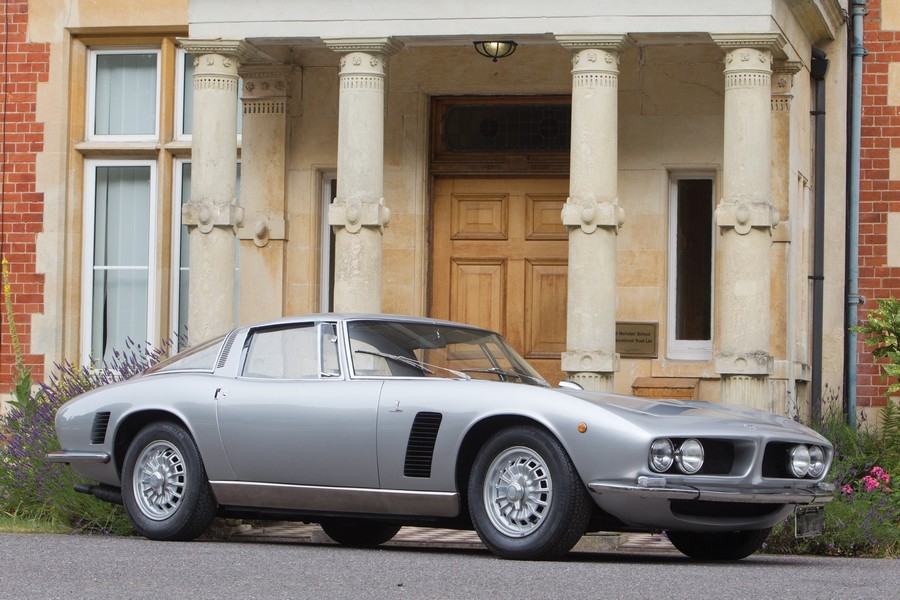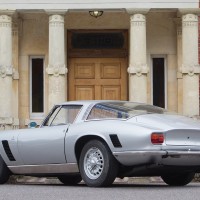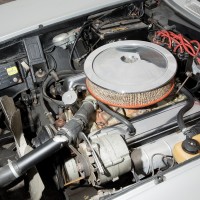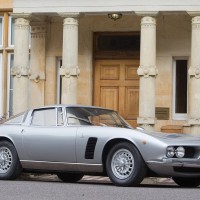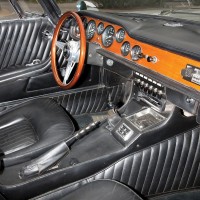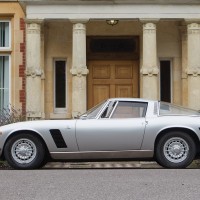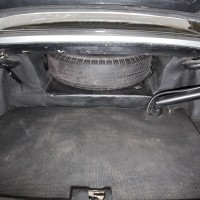SCM Analysis
Detailing
| Vehicle: | 1967 Iso Grifo GL 300 |
| Number Produced: | 412 |
| Original List Price: | $14,000 |
| Tune Up Cost: | $250 |
| Chassis Number Location: | Metal plate on top of right front shock tower |
| Engine Number Location: | Top left flange at rear of block |
| Club Info: | Iso |
| Website: | http://www.isobizclub.com |
This car, Lot 233, sold for $244,269, including buyer’s premium, at RM’s London auction on September 9, 2013.
Hybrids. How did a genre formerly comprising some of the best performance cars ever conceived become, a mere 40 years later, a genre of cars for people who hate cars and merely view them as basic transportation between protests and organic food stores?
Perhaps Publisher Martin’s next title, Hyper Mile Market, will explore that. So what are some hybrids we actually care about? Shelby Cobras. Sunbeam Tigers. Griffiths. DeTomaso Mangustas, Panteras and Longchamps. Intermeccanica Italias. Facel Vegas. And, of course, Iso Rivoltas, Grifos, and their sibling Bizzarrini Stradas. None of us should see these wonderful cars at Whole Foods anytime soon.
From appliances to sports cars
I would be doing a disservice by not offering a bit of the fascinating backstory of Renzo Rivolta and Giotto Bizzarrini, the men behind the Iso Grifo. “Iso” comes from Rivolta’s very successful Isothermos refrigeration unit company, which he founded in 1939. After World War II, Rivolta no longer found building appliances “cool,” and he began building famously robust, high-quality scooters and motorbikes such as the Isomoto and Isosport. But perhaps his most famous product was the Isetta microcar, which Rivolta later licensed to manufacturers worldwide — the most well known of which is BMW.
This success allowed Rivolta to follow his dream of building a powerful GT car. To accomplish this, Rivolta hired Giotto Bizzarrini. Bizzarrini’s résumé was certainly impressive, as he was a former Alfa Romeo engineer and held chief engineer and test-driver titles at Ferrari. His projects there included the 250 TR, 250 SWB, and 250 GTO. Rivolta hired Bizzarrini in large part to develop his new GT car’s unified pressed-steel chassis and body structure.
Add Rivolta’s choice of designer — Giorgetto Giugiaro with coachbuilder Bertone — and it was a pretty good cast of players.
Italian design, American power
Bolstering all this was the decision to use Chevrolet 327-ci small block V8s fitted with a Borg-Warner T-10 4 speeds, a De Dion rear suspension with the Salisbury/Dana 44 differential (also used in Cobras, E-types, and Jeeps, among others) and 4-wheel disc brakes sourced from Girling. It was an international tour de force of components, the result of which was the modestly named Iso Rivolta GT, which debuted in 1962.
To follow the GT, Rivolta took its chassis and created the Grifo. A muscular two-seat supercar, it offered visual excitement more befitting of the stout chassis and powertrain that was hidden under the reserved 2+2 GT. As with all of Giugiaro’s designs, it was the complete package, and every detail was thought out.
Not satisfied with merely plugging in the engines sourced from Chevrolet, Iso Rivolta balanced, blueprinted and tested each unit before installing them in Grifos. Most were dressed with beautiful cast-aluminum oil pans and other trimmings that made the install look like it belonged there — instead of being the mechanical equivalent of a lost American tourist wondering how to order a cappuccino.
This Iso Rivolta-tuned Corvette power, along with the available 3.07 final drive, tall 205-15 tires and 3,200-pound curb weight, gave Grifos enough high-speed ability to run with anything from Maranello. Of course, much as with other supercars of the day, such as Ferrari 275 GTBs, the Grifo’s power Girling brakes were good for one or two high-speed stops, but not a day at the track.
And the Rivolta/Bizzarrini pairing? The two decided to part ways shortly after the Grifo was a reality. Rivolta always wanted to build grand touring cars of the highest order, while Bizzarrini was clearly deeply rooted in competition and wanted to build all-out GT racing cars. The result was that Rivolta continued to build touring cars and Bizzarrini formed his own company (Bizzarrini SpA) which took the Grifo chassis and clothed it in sensational bodywork to create the car that became the Bizzarrini 5300 Strada with various road and racing incarnations.
Hidden rust a possible gremlin
The Grifo’s styling has aged quite well, and obviously the rugged drivetrains are simplicity personified. Yet Grifos are not without caveats today. The pressed-steel unibody, while revolutionary at the time, is quite prone to rusting due to an absolute complete lack of any rust-proofing during manufacture.
Much like a Pantera, a Grifo can look exceptionally clean from the outside, but a little poking around can expose serious structural issues. Not helping this was the standard Italian practice of slathering the entire chassis with an asphalt-based undercoating over bare metal. This undercoat will dry out and crack, allowing moisture to work its way in between bare steel. The comfy layer of undercoating gives that hidden water years to convert steel into rust.
Also, while most mechanical bits were used in many other cars and easy to source, finding the Grifo-specific bits today, if missing, can produce massive brain damage.
While I did not personally inspect our subject Grifo, upon reviewing the photos, it does appear to be a nice original example — although it looks slightly unloved.
It is missing its trunk script and hood badge, and the grille badge is mounted on the hood. Some underhood components are missing or not original; most noticeable are the incorrect radiator and missing fan shroud. The interior appears very clean and original, including the original shifter (a plus for originality but a minus for speed shifting).
Bargain style and grunt
The RM catalog does not mention if the engine and transmission are original (Iso Rivolta did stamp engine numbers, and even numbered air cleaners), any restoration history, or report of this car’s current structural or physical fitness.
The last sale I was able to find of this particular car was Coy’s London auction in 1997 for about $43,400, and it has been reported to have been on display at a museum in the Cayman Islands since.
However, if the car retains its original drivetrain, has a solid chassis and body, and runs and drives reasonably well, I would call this car well bought. Why? With classic Italian supercar styling and American grunt under the hood, a good Grifo offers exclusivity and performance for what amounts to a modern-day buyer’s premium of most comparable Italian cars of the day. ?
(Introductory description courtesy of RM Auctions.)
